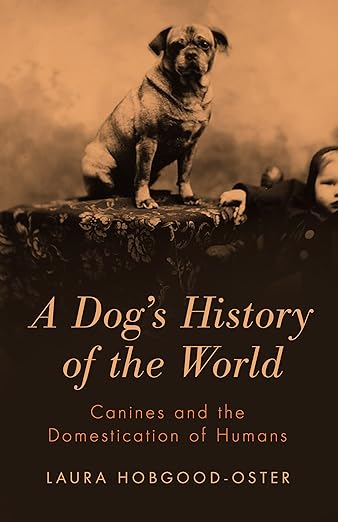Of Gods and Men (and Dogs)
Humanimalia 6.1 (Fall 2014)
This modest volume does not mean to offer a startling new thesis about the origin and development of dogs, but it is a very readable account, especially strong in its discussion of dogs in ancient times. Rather than a chronological history, Hobsgood-Oster organizes her book around six themes: hunting and herding, religious roles, Ahealing and saving,” war and empire, breeding, and the “dog-human bond.” This scheme works well and avoids too much repetition, while moving swiftly through the ages in each section. Other general histories of the co-evolution of dogs and humans exist, of course, although they are breezier in their approaches, including Katherine Rogers’s First Friend: A History of Dogs and Humans (2005) and Stanley Coren’s The Pawprints of History: Dogs and the Course of Human Events (2002). While Hobsgood-Oster’s book is by no means completist in its approach, it has a more scholarly development, well-supported in its claims, with extensive and useful endnotes and bibliography. It is a thoughtful, lively, and up-to-date introduction to its subject — sadly or perhaps fortunately, however, it is not from the dog’s viewpoint, as the title implies.
The book’s introduction demonstrates the technique Hobsgood-Oster will employ throughout. She begins with a concrete example, in this case the story of Laika, the first dog in space, and uses it as a working metaphor of dogs as human beings’ companions: “Giant steps, like the rocket blast from earth into space, often accompanied by tragic moments such as the death of the canine cosmonaut Laika, mark the human story” (2). The author continues throughout the book to acknowledge the mixed blessing that human companionship offers.
Chapter 1, “Strangers No More: Partners in the Hunt and Herd,” offers Hobsgood-Oster’s version of co-evolution, a variation on the Coppingers’ famous thesis that dogs evolved through their own breeding around the middens of humans, shaped by their smaller flight distance (Dogs: A Startling New Understanding of Canine Origin, Behavior and Evolution [2001]). Citing developments in the field of zooarchaeology, Hobsgood-Oster theorizes that “humans had paired up with canines twice, once with the proto-wolf-dog before the Ice Age and then again after that cataclysmic period ended” (14). Along with the usual changes that co-evolution wrought (floppy ears, curly tails, along with shorter flight distance) she points out how both dogs and humans changed their diets as humans grew more reliant on agriculture.
While chapter 1 never gets past ancient Rome, Chapter 2, “Journey to the Afterlife: Best Friends Forever,” moves back and forth between ancient burial practices and modern pet cemeteries to make an elegant point about the liminality of dogs as “providing a border between humans and nature ... hover[ing] between nature and culture, human and animal” (49). And, while showing how ancient dogs were honored by being buried with their human companions, Hobsgood-Oster also acknowledges that “this was likely not a choice made by the dogs ... it was not a timely death for the canines” (48). Generally, her discussions of pre-historic archaeological evidence are fascinating.
In Chapter 3, “Healing and Saving: Life is Better with Dogs,” Hobsgood-Oster jumps somewhat disconcertingly from ancient and medieval examples to contemporary ones. Nevertheless, I was happy to learn about the Sumerian-Babylonian goddess Gula, who was sometimes human in shape and sometimes a dog; and about the medieval Saint Guignefort, who was a dog through and through. I had been more familiar with the service dogs whom she describes in the second part of the chapter.
The remaining three chapters cover pretty familiar territory. Chapter 4 demonstrates how dogs used for warfare and conquest both suffered and caused suffering as they were manipulated by the powers of empire and colonization. (Again, there is a large historical gap as Hobsgood-Oster leaps from William the Conqueror to the American Civil War.) Chapter 5 discusses the plasticity of dogs and how extreme breeding practices have endangered their genetic health (think of the giant breeds and the English bulldog, for instance). The final chapter offers some summarizing remarks about human-dog interdependence.
The last two chapters seemed less carefully written than the previous ones and I found myself wondering if they had been more rushed or if the author was less engaged with their content. This was particularly noticeable because the writing in the first four chapters was so skilled. I would also have liked more historical continuity in the book’s coverage but suspect that page limits may have played a role in its somewhat hurried approach. Nevertheless, as an introductory text it was quite successful, and it also provided fascinating glimpses into the pre-historic traces of the dog that zooarchaeology makes available. Whenever it seemed about to lapse into over-sentimentalizing, as is so easy to do when talking about dogs, the novel resisted the impulse by emphasizing again the cost of hanging around with human beings.
